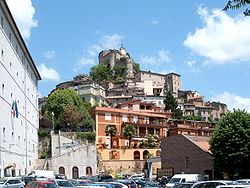Subiaco, Lazio
| Subiaco | ||
|---|---|---|
| Comune | ||
| Comune di Subiaco | ||
 |
||
|
||
| Location of Subiaco in Italy | ||
| Coordinates: 41°56′N 13°06′E / 41.933°N 13.100°ECoordinates: 41°56′N 13°06′E / 41.933°N 13.100°E | ||
| Country | Italy | |
| Region | Lazio | |
| Province / Metropolitan city | Rome | |
| Government | ||
| • Mayor | Francesco Pelliccia (since May 2011) | |
| Area | ||
| • Total | 63 km2 (24 sq mi) | |
| Elevation | 408 m (1,339 ft) | |
| Population (31 August 2014) | ||
| • Total | 9,189 | |
| • Density | 150/km2 (380/sq mi) | |
| Demonym(s) | Sublacensi | |
| Time zone | CET (UTC+1) | |
| • Summer (DST) | CEST (UTC+2) | |
| Postal code | 00028 | |
| Dialing code | 0774 | |
| Patron saint | St. Benedict | |
| Saint day | March 21 | |
| Website | Official website | |
Subiaco is a town and comune in the Metropolitan City of Rome, in Lazio, central Italy, 40 kilometres (25 mi) from Tivoli alongside the river Aniene. It is mainly renowned as a tourist and religious resort for its sacred grotto (Sacro Speco), in the medieval St. Benedict's Abbey, and for the Abbey of Santa Scolastica.
At a time when several German monks had been assigned to the monastery, German printers established a printing press in the town. They printed the first books in Italy in the late 15th century.
Among the first ancient settlers in the area were the Aequi, an Italic people. In 304 BC they were conquered by the Romans, who introduced their civilization and took advantage of the waters of the Aniene river. The present name of the city comes from the artificial lakes of the luxurious villa that emperor Nero had built: in Latin Sublaqueum means "under the lake." The name was applied to the town that developed nearby. The biggest of the three Subiaco Dams was the highest dam in the world until its destruction in 1305. After the fall of the Roman Empire, the villa and the town were abandoned, becoming almost forgotten ruins.
When St. Benedict, at the age of fourteen (c. 494), retired from the world and lived for three years in a cave above the river Anio, he was supplied with the necessaries of life by a monk, St. Roman. From this grotto, St. Benedict developed the concepts and organization of the Benedictine Order. He built twelve monasteries,including one at the grotto, and placed twelve monks in each. In 854 a record noted its renovation. In this year, Pope Leo IV is said to have consecrated an altar to Sts. Benedict and Scholastica and another to St. Sylvester. Another renovation took place in 1053 under Abbot Humbert of St. Scholastica. Abbot John V, created cardinal by Pope Gregory VII, made the grotto the terminus of a yearly procession, built a new road, and had the altars reconsecrated.
...
Wikipedia


